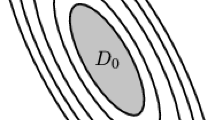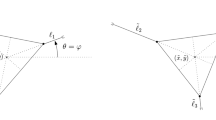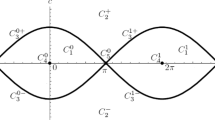Abstract
The goal of this paper is to describe a method to solve a class of time optimal control problems which are equivalent to finding the sub-Riemannian minimizing geodesics on a manifold M. In particular, we assume that the manifold M is acted upon by a group G which is a symmetry group for the dynamics. The action of G on M is proper but not necessarily free. As a consequence, the orbit space M/G is not necessarily a manifold but it presents the more general structure of a stratified space. The main ingredients of the method are a reduction of the problem to the orbit space M/G and an analysis of the reachable sets on this space. We give general results relating the stratified structure of the orbit space, and its decomposition into orbit types, with the optimal synthesis. We consider in more detail the case of the so-called K−P problem where the manifold M is itself a Lie group and the group G is determined by a Cartan decomposition of M. In this case, the geodesics can be explicitly calculated and are analytic. As an illustration, we apply our method and results to the complete optimal synthesis on S O(3).




Similar content being viewed by others
Notes
That is, a manifold with the action of a Lie transformation group.
That is, for any p∈M, g 1 and g 2 in G, (g 2 g 1)p = g 2(g 1 p).Every aspect of the theory goes through for right actions with minor modification, that is, g 2(g 1 p)=(g 1 g 2)p.
That is, the action map α:G×M→M×M defined by α(g,p)=(g p,p) is proper, that is, the preimage of any compact set is compact.
The intuitive idea of the frontier connection is that smaller dimensional manifolds in the partition are either totally detached from higher dimensional manifolds (that is the intersection with the closure is empty) or they are part of the boundary.
And therefore in the critical locus \({\mathcal {CR}}(M)\) cf. Proposition 2.1.
If \(A\in \mathcal {K}\) and \(D \in \mathcal {P}\)@@@@
@@@where we have used the property of the Killing form that for every Lie algebra automorphism ϕ, K i l l(A,D) = K i l l(ϕ A,ϕ D).
Notice that we could have as well set up the whole treatment for right invariant vector fields but we could have given an analogous treatment for left invariant vector fields.
Consider a connected component of G. We know that there exists a number of right invariant vector fields X 1,X 2,…,X m in \(\mathcal {K}\) such that denoting by σ 1,t , σ 2,t ,..., σ m,t the corresponding flows, we have \(\sigma _{m,t_{m}} \circ \sigma _{{m-1},t_{m-1}} \circ {\cdots } \circ \sigma _{1,t_{1}} (g_{j})=g\). For every r=1,…m the map σ r,t is real analytic as a function of t. Denote by \(\bar g:=\sigma _{1,t_{1}}(g_{j})\). We want to show that \({\Phi }_{\bar g * }\mathcal {P} \subseteq \mathcal {P}\) and applying this m times we have that \({\Phi }_{g*} \mathcal {P} \subseteq \mathcal {P}\). Consider K in \(\mathcal {K}\) and \(P \in \mathcal {P}\) and the Killing inner product \(B(K, {\Phi }_{\sigma _{1, t}(g_{j}) *} P)\) which is a real analytic function of t at every point in M and it is zero for t=0. By taking the k-th derivative of this function at t=0, we obtain, using the definitions of Lie derivative@@@
where \(ad_{X_{1}}^{k}\) denotes the k−the repeated Lie bracket with X 1 and we have used Eq. 22.
The example of S U(2) treated in [4] and the example of S O(3) of the next section are K−P problems of this type.
Here, with minor abuse of notation, we identify \(\mathcal {K}\), \(\mathcal {L,}\) and \(\mathcal {P}\) with the spaces of matrices representing the corresponding vector fields.
This is done for example in the next section in Proposition 5.3.
Typical cases in the literature look at a Lie group M where the conjugation action on M is given by M itself and not by a subgroup G of M as in our case.
Here, we use the calculation of [7] section 3.2.1.
References
Agrachev A, Barilari D, Boscain U. Introduction to Riemannian and sub-Riemannian geometry, Lecture Notes SISSA. Italy: Trieste; 2011.
Agrachev A, Sachkov Y. Control theory from the geometric viewpoint, Encyclopaedia of Mathematical Sciences, 87. Berlin: Springer; 2004.
Albertini F, D’Alessandro D. Minimum time optimal synthesis for two level quantum systems. J Math Phys 2015;56:012106.
Albertini F, D’Alessandro D. Time optimal simultaneous control of two level quantum systems, submitted to Automatica.
Alekseevsky D, Kriegl A, Losik M, Michor P. The Riemannian geometry of orbit spaces. The metric, geodesics, and integrable systems. Publ Math Debrecen 2003; 62:247–276.
Boscain U, Chambrion T, Gauthier JP. On the K+P problem for a three-level quantum system: optiMality implies resonance. J Dyn Control Syst 2002;8(4):547–572.
Boscain U, Rossi F. Invariant Carnot-Caratheodory metric on s 3, S O(3) and S L(2) and lens spaces. SIAM J Control Optim 2008;47:1851–1878.
Bredon GE, Vol. 46. Introduction to compact transformation groups pure and applied mathematics. New York: Academic Press; 1972.
D’Alessandro D, Albertini F, Romano R. Exact algebraic conditions for indirect controllability of quantum systems. SIAM J Control Optim 2015;53(3):1509–1542.
Echeverrìa-Enriquez A, Marìn-Solano J, Munõz Lecanda MC, Roman-Roy N. Geometric reduction in optimal control theory with symmetries. Rep Math Phys 2003;52:89–113.
Bredon GE, Vol. 46. Introduction to compact transformation groups pure and applied mathematics. New York: Academic Press; 1972.
Filippov AF. On certain questions in the theory of optimal control. SIAM J on Control 1962;1:78–84.
Grizzle J, Markus S. The structure of nonlinear control systems possessing symmetries. IEEE Trans Automat Control 1985;30:248–258.
Grizzle J, Markus S. Optimal control of systems possessing symmetries. IEEE Trans Automat Control 1984;29:1037–1040.
Ibort A, De la Pen̈a TR, Salmoni R. Dirac structures and reduction of optimal control problems with symmetries, preprint; 2010.
Jacquet S. Regularity of the sub-Riemannian distance and cut locus, in nonlinear control in the year 2000. Lecture Notes Control Inf Sci 2007;258:521–533.
Knapp A, Vol. 140. Lie groups beyond and introduction, Progress in Mathematics. Boston: Birkhäuser; 1996.
Koon WS, Marsden JE. The Hamiltonian and Lagrangian approaches to the dynamics of nonholonomic systems. Rep Math Phys 1997;40:21–62.
Marsden JE, Ratiu TS. Introduction to mechanics and symmetry. New York: Springer; 1999.
Marsden JE, Weinstein A. Reduction of symplectic manifolds with symmetry. Rep Math Phys 1974;5:121–130.
Martinez E. Reduction in optimal control theory. Rep Math Phys 2004;53(1):79–90.
Meinrenken E. 2003. Group actions on manifolds (lecture notes) University of Toronto.
Michor P. Unknown Month 1996. Isometric actions of lie groups and invariants, Lecture Course at the University of Vienna.
Montgomery R. A Tour of sub-Riemannian geometries, their geodesics and applications, volume 91 of Mathematical Surveys and Monographs. RI: American Mathematical Society; 2002.
Monti R. The regularity problem for sub-Riemannian geodesics, in geometric control and sub-Riemannian geometry. Springer INdAM Series. In: Stefani G, Boscain U, Gauthier J-P, Sarychev A, and Sigalotti M, editors; 2014. p. 313–332.
Nijmeijer H, Van der Schaft A. Controlled invariance for nonlinear systems. IEEE Trans Automat Control 1982;27:904–914.
Ohsawa T. Symmetry reduction of optimal control systems and principal connections. SIAM J Control Optim 2013;51(1):96–120.
Acknowledgements
Domenico D’Alessandro’s research was supported by the ARO MURI grant W911NF-11-1-0268. Domenico D’Alessandro also would like to thank the Institute of Mathematics and its Applications in Minneapolis and the Department of Mathematics at the University of Padova, Italy, for kind hospitality during part of this work.
Author information
Authors and Affiliations
Corresponding author
Rights and permissions
About this article
Cite this article
Albertini, F., D’Alessandro, D. On Symmetries in Time Optimal Control, Sub-Riemannian Geometries, and the K−P Problem. J Dyn Control Syst 24, 13–38 (2018). https://doi.org/10.1007/s10883-016-9351-6
Received:
Published:
Issue Date:
DOI: https://doi.org/10.1007/s10883-016-9351-6




